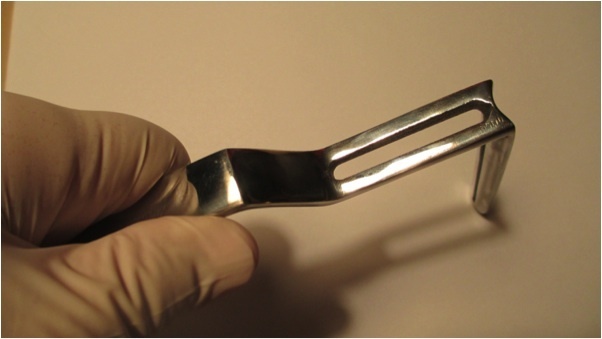|
Back to Annual Meeting Posters
Creation and Evaluation of a Novel Device for Rapid and Safe Removal of the Gallbladder Through Laparoscopic Port Sites
Joshua M. Judge*1, Gina Petroni2, William H. Guilford3, Craig L. Slingluff1, Peter T. Hallowell1
1Surgery, University of Virginia, Charlottesville, VA; 2Public Health Sciences, University of Virginia, Charlottesville, VA; 3Biomedical Engineering, University of Virginia, Charlottesville, VA
Objective: To obtain preliminary data on the safety and usefulness of a novel device for extracting large and difficult-to-remove gallbladders during laparoscopic cholecystectomy.
Background: A common source of frustration during laparoscopic cholecystectomy involves extraction of the gallbladder through a port site smaller than the gallbladder itself. Current techniques risk rupture of the bag or gallbladder and can be time consuming, leading to increased procedural cost. We developed and tested a novel device for the safe, minimal enlargement of laparoscopic port sites to extract large, stone-filled gallbladders from the abdomen. This device is a stainless-steel device with a vertical retraction blade and a linear aperture in the handle that admits a scalpel, which can be advanced along the back side of the vertical blade, enabling a controlled sharp enlargement of the laparoscopic port site and rapid removal of the gallbladder. Additionally, we sought to estimate the proportion of patients whose gallbladders are difficult to extract from the abdomen.
Methods: This IRB-approved, single institutional, single surgeon study was offered to patients presenting for laparoscopic cholecystectomy with diagnoses high risk for difficult gallbladder extraction (those with cholelithiasis with or without complicating features). When gallbladder extraction was attempted, if successful without enlargement of the port site, the device was not used. If the gallbladder could not be removed with gentle traction on the specimen bag, and enlargement of the port site was considered, the device was used. The time required for extraction, from insertion of the device until complete specimen removal, was recorded. The study surgeon provided Likert scores for perceived utility of the device in each case. Patients were seen in follow-up irrespective of device use and assessed for pain level, cosmetic effect, and infectious complications.
Results: Thirty-nine patients were enrolled in the study. For twenty (51%) there was difficulty extracting the gallbladder, requiring use of the device. Average extraction time for the first 8 patients was 120 seconds. After a planned interim analysis, an improved device was produced and used in the next 12 patients, for whom the average extraction time was 24 seconds. There were no adverse events. Post-operative pain rating and incision cosmesis scores were comparable between patients with or without use of the device. No wound infections or other wound complications were encountered.
Conclusion: Difficult gallbladder extraction during laparoscopic cholecystectomy occurs in a large proportion of patients. The study device can safely and rapidly extract impacted gallbladders through the abdominal wall port site and is judged a useful tool by the study surgeon.
Time for extraction of gallbladder with use of extraction device
| Mean (sec) | Median (sec) | Range (sec) | | Prototype (patients 1-8) | 120 | 70 | 27 - 416 | | Final device (patients 9-20) | 24 | 24 | 10 - 42 | | Total (n = 20) | 63 | 32 | 10 - 416 |

Oblique view from the top of the device
Back to Annual Meeting Posters
|


